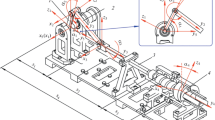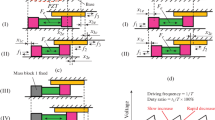Abstract
A partially compliant novel translational double dwell mechanism is presented in this article. The designed mechanism consists of initially straight and preloaded pinned-pinned compliant links, rigid crank, slider-rail system and a DC motor. Slider doesn’t move until the critical buckling load is achieved and then snaps to its maximum and returns back to initial position as the crank completes a full rotation. Motion behavior of elastic members depending on the geometry and loading are investigated using Elastica theory. Kinematic analysis and dynamical model are obtained by representing the compliant pinned-pinned members as translational springs using polynomial formulation method. Mechanism behavior is also analyzed in Adams FlexView. Mechanism is built by 3D printing the flexible parts using polylactic acid (PLA). Displacement of the slider along with the deformation of buckling beams are recorded and deflection shapes are detected by machine vision measurement while the crank is subjected to complete rotation. Slider position is also recorded by a laser displacement sensor. Dynamical model results are validated by the experimental setup, machine vision measurement and Adams simulations.
Similar content being viewed by others
References
L. L. Howell, Compliant Mechanisms, John Wiley & Sons (2001).
L. L. Howell, S. P. Magleby and B. M. Olsen (eds.), Handbook of Compliant Mechanisms, John Wiley & Sons (2013).
K.-J. Lu and S. Kota, Design of compliant mechanisms for morphing structural shapes, Journal of Intelligent Material Systems and Structures, 14(6) (2003) 379–391.
A. Tekeş, Ü. Sönmez and B. A. Güvenç, Compliant folded beam suspension mechanism control for rotational dwell function generation using the state feedback linearization scheme, Mechanism and Machine Theory, 45(12) (2010) 1924–1941.
A. Saxena and G. K. Ananthasuresh, Topology synthesis of compliant mechanisms for nonlinear force-deflection and curved path specifications, Journal of mechanical Design, 123(1) (2001) 33–42.
S. Perai, Methodology of compliant mechanisms and its current developments in applications: A review, American Journal of Applied Sciences, 4(3) (2007) 160–167.
E. G. Merriam, J. E. Jones and L. L. Howell, Design of 3D-printed titanium compliant mechanisms, Proceedings of the 42nd Aerospace Mechanisms Symposium, May 14–16 (2014).
A. T. Gaynor, N. A. Meisel, C. B. Williams and J. K. Guest, Multiple-material topology optimization of compliant mechanisms created via polyjet three-dimensional printing, Journal of Manufacturing Science and Engineering, 136(6) (2014) 061015.
S. K. Moon, Y. E. Tan, J. Hwang and Y.-J. Yoon, Application of 3D printing technology for designing light-weight unmanned aerial vehicle wing structures, International Journal of Precision Engineering and Manufacturing-Green Technology, 1(3) (2014) 223–228.
K. J. Waldron, G. L. Kinzel and S. K. Agrawal, Kinematics, Dynamics, and Design of Machinery, John Wiley & Sons (2016).
U. Sönmez, Introduction to compliant long-dwell mechanism synthesis using buckling arc theory, ASME 2003 International Design Engineering Technical Conferences and Computers and Information in Engineering Conference, American Society of Mechanical Engineers (2003).
P. S. Shiakolas, D. Koladiya and J. Kebrle, On the optimum synthesis of six-bar linkages using differential evolution and the geometric centroid of precision positions technique, Mechanism and Machine Theory, 40(3) (2005) 319–335.
E. Barrett et al., The SHERPA gripper: Grasping of small-scale UAVs, 2016 IEEE International Symposium on Safety, Security, and Rescue Robotics (SSRR), IEEE (2016).
U. Sonmez, Compliant Mechanism Design and Synthesis Using Buckling and Snap-through Buckling of Flexible Members, Ph.D. Dissertation, Pennsylvania State University (2000).
U. Sonmez, Compliant MEMS crash sensor designs: the preliminary simulation results, 2007 IEEE Intelligent Vehicles Symposium, IEEE (2007).
U. Sönmez, Introduction to compliant long dwell mechanism designs using buckling beams and arcs, Journal of Mechanical Design, 129(8) (2007) 831–843.
A. Tekeş, Ü. Sönmez and B. A. Güvenç, Compliant folded beam suspension mechanism control for rotational dwell function generation using the state feedback linearization scheme, Mechanism and Machine Theory, 45(12) (2010) 1924–1941.
A. Tekes and H. Lin, Compliant translational double exact dwell mechanism, ASME 2018 International Mechanical Engineering Congress and Exposition, American Society of Mechanical Engineers (2018).
Author information
Authors and Affiliations
Corresponding author
Additional information
Recommended by Associate Editor Daeil Kwon
Ayse Tekes is an Assistant Professor in Mechanical Engineering Department at Kennesaw State University. She received all her degrees in mechanical engineering from Istanbul Technical University. Her research interest includes design, modeling and analysis of compliant mechanisms.
Hongkuan Lin is an undergraduate student in mechanical engineering at Kennesaw State University. His research interest includes design and modeling of compliant translational/ rotational dwell and bistable mechanisms.
Kevin McFall is an Associate Professor and Chair of Mechatronics Department at Kennesaw State University. His current research focuses on autonomous vehicles and deep learning, directing numerous student teams to develop sensor systems and actuation control for self-driving cars and robots.
Rights and permissions
About this article
Cite this article
Tekes, A., Lin, H. & McFall, K. Design, modelling and experimentation of a novel compliant translational dwell mechanism. J Mech Sci Technol 33, 3137–3145 (2019). https://doi.org/10.1007/s12206-019-0609-2
Received:
Revised:
Accepted:
Published:
Issue Date:
DOI: https://doi.org/10.1007/s12206-019-0609-2




